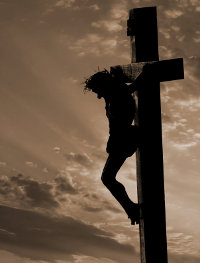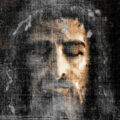
The cross is the universal Christian icon, yet there are two common forms. The empty cross focuses on Jesus’ resurrection and is preferred by most Protestants. The crucifix focuses on Jesus’ ultimate sacrifice and is preferred by Catholics. Both Protestants and Catholics alike have deep reverence for either form.
A crucifix may be found wherever there are Catholics – on rosaries and necklaces; in our classrooms, hospitals, and of course, churches. When you visit a Catholic church, a crucifix is prominently displayed. At my church, it is imposing – maybe 6 feet tall – and suspended in the air high above the altar. It is an integral part of every Mass. The GIRM (General Instruction of the Roman Missal – the document for the conduct of Mass) states that a crucifix is required during the celebration of the Mass:
There is also to be a cross, with the figure of Christ crucified upon it, either on the altar or near it, where it is clearly visible to the assembled congregation. It is appropriate that such a cross, which calls to mind for the faithful the saving Passion of the Lord, remain near the altar even outside of liturgical celebrations.
GIRM 308
I feel closer to our Lord in its presence. I not only remember Jesus generally, but especially his ultimate and undeserved gift to us.
A crucifix is certainly an “uncomfortable” image. It shows us, in a very mild form, a portion of Christ’s Passion. It is the greatest reminder of His infinite love for us, accepting the full consequences of our sins. Our focus throughout the year is therefore on our redemption through His sacrifice on Good Friday even more than His resurrection on Easter Sunday.
Father Vincent Serpa, a Dominican Friar and Catholic Answers Apologist offers this excellent reflection on the Passion of Our Lord:
The agony in the garden was really the agony in His mind. He suffered the passion in His mind before He suffered it in His body – to the point of actually affecting the latter by sweating blood. But from then on, it was His bodily suffering that affected His mental suffering.
At the base of all His suffering was the one thing that human beings dread the most: rejection. He was betrayed by Judas, denied by Peter and abandoned by all the rest of His Apostles; those He had hand picked as His closest intimates. He was most rejected by those who put Him to death. They not only wanted Him dead, they wanted Him to suffer. They not only considered Him to be worth nothing, they considered Him to be worth minus nothing! This significance was not lost on Him. He felt fully the rejection as each physical agony reminded Him.
So we thank Him for joining us on our human journey and actually choosing to experience what we fear the most.
We thank Him for enduring the arrest and the cruelty of the guards and the Sanhedrin. We thank Him for enduring the cruelty of Pilate who allowed Him to be executed rather than risk his own political ruin – and for the cruelty of Herod who wanted to be entertained by having Him work a miracle. We thank Him for all the time He spent satisfying their preoccupation with themselves, just delaying His ultimate death. We thank Him for the anxiety of that night in a cell.
The next morning He was brutally scourged with such intensity and violence that He became as an aged man in a matter of minutes. His multiple wounds bloodied His entire body. The loss of so much blood not only severely weakened Him; it also caused a severe, throbbing headache that remained with Him for the duration.
We thank Him for this and for the mockery He received when they put a purple cloth on His shoulders and pushed a crown of thorns down into His head which intensified His headache. They blindfolded Him and slapped Him, insisting that He “prophesy” who had hit Him. They spat on Him and beat Him. But it was they who were blind. He knew who they were. This is what we do when we sin. We blot him out of our consciousness as if He can’t see us. But it is we who choose to not see.
He stood at the praetorium in utter disgrace according to the attitude of the crowd — while in reality, He stood in utter glory: almighty God, being present to every person who has ever suffered rejection, joining them in their moment of pain. It was there that He was sentenced to death by crucifixion. As a further humiliation, He was forced to carry His instrument of execution. He revealed to St. Bernard that carrying the cross was His most painful agony. He was so weak, He could hardly walk. So the weight of the cross on His shoulder was unbearable. It most likely dislocated His shoulder. It is not surprising that He fell down on the stone streets that were filthy with animal dung &ndash with the cross on top of Him. And He got up each time.
It was only with the help of Simon of Cyrene that He made it to the top of Calvary. There they drove the nails into the carpal tunnels of His hands, causing pain throughout His upper body. The nail in His feet registered great pain through all the sensitive nerves there. When the cross was righted, His up-stretched arms squeezed His lungs and He began to pant for lack of oxygen. So He had to push down on His crucified feet to push His body up in order to fill His lungs with air. This took great effort because He was so weak. Yet He managed to maintain such effort for three hours of agony which increased gradually as He became weaker moment by moment.
By the end of the third hour, His agony was at its peak and His self-gift was exquisite. He had come to the point where His strength simply gave out and He suffocated. In this eternal moment as He died, He gave us His life. Transcending time, this moment of divine love is present to us in the tabernacles of the world.
Thank you, Lord. We adore you O Christ and we praise you. By your holy cross, you have redeemed the world!
Lamb of God, you take away the sins of the world. Through the eyes of faith we see the glory of the crucifix. Good Friday wishes to you all.


























Beautiful! Thank you, for another incredible post.